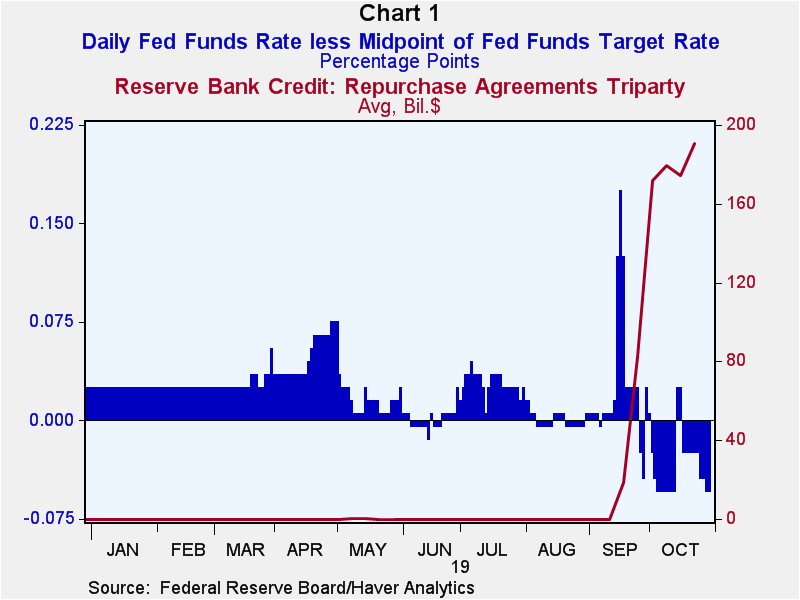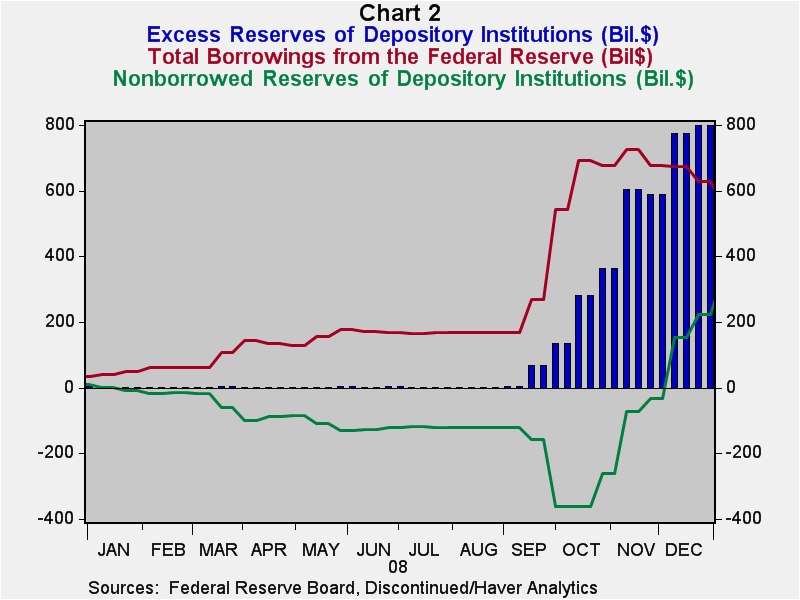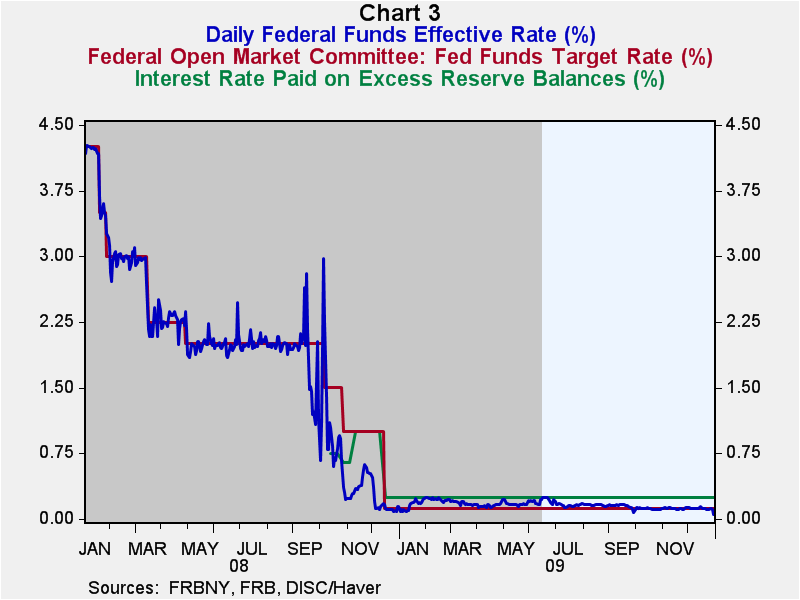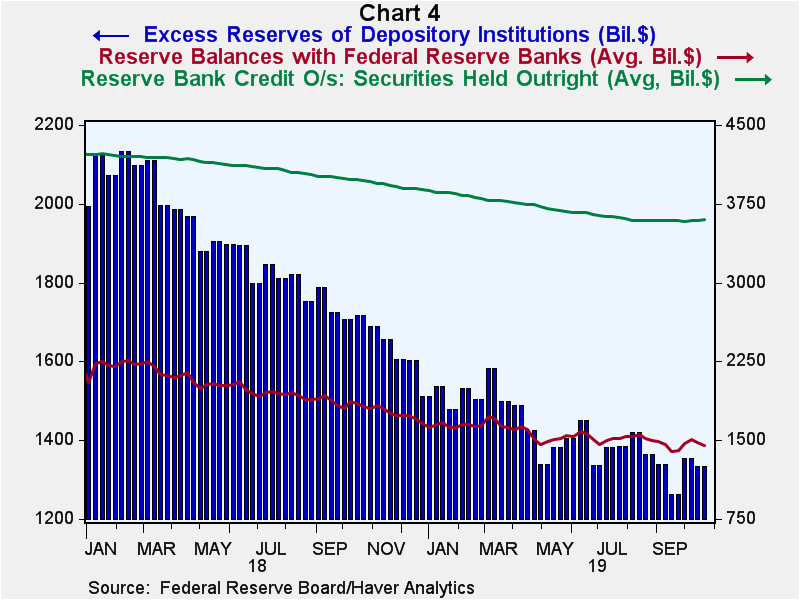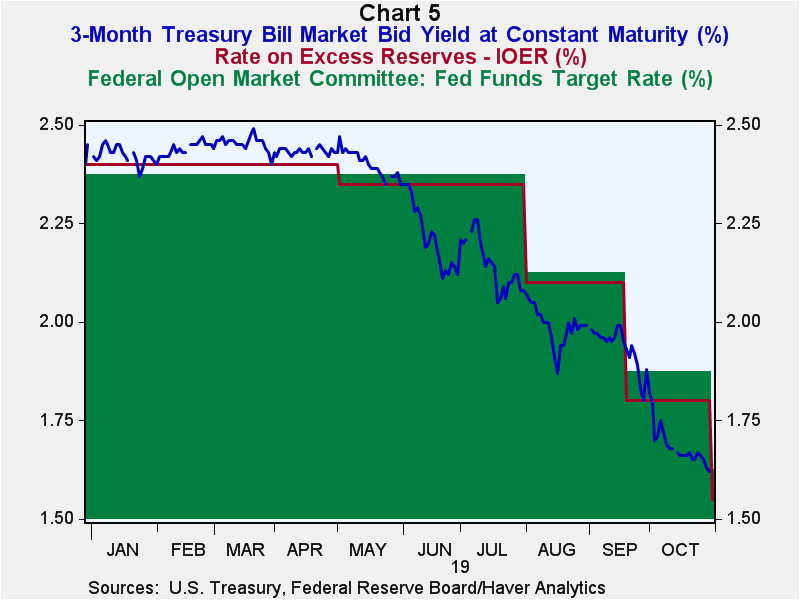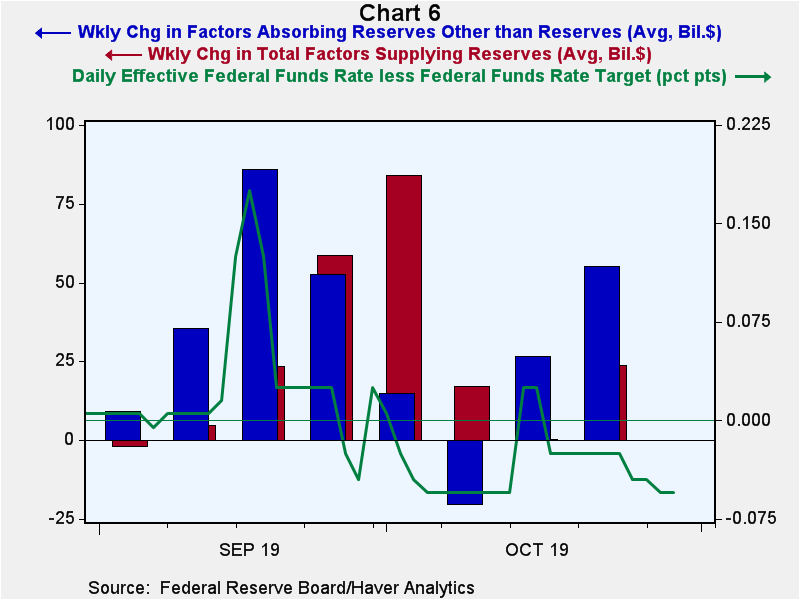 Global| Oct 31 2019
Global| Oct 31 2019The Fed to Banks: Why Don't You Just Tell Us How Many Reserves You Need?*
|in:Viewpoints
Summary
In mid September of this year, the Fed lost control of the federal funds rate to the upside. On September 17, the effective federal funds rate exceeded the midpoint of its target level by 17.5 basis points (see Chart 1, the blue [...]
In mid September of this year, the Fed lost control of the federal funds rate to the upside. On September 17, the effective federal funds rate exceeded the midpoint of its target level by 17.5 basis points (see Chart 1, the blue bars). This spike in the federal funds rate was indicative of an increased demand for cash reserves at the Fed by depository institutions(banks) relative to the quantity of cash reserves being supplied by the Fed. In order to accommodate this excess demand for reserves and to bring the federal funds rate back down to its target level, the Fed began in mid September adding reserves to the depository institution system via repurchase agreements (the red line in Chart 1). A repurchase agreement by the Fed is an operation by which the Fed temporarily purchases securities from the public. In effect, a Fed repurchase agreement is a temporary loan to a financial institution that is collateralized by a Treasury security or a federal government guaranteed security. Prior to this past September, the Fed has not injected reserves into the financial system via repurchase agreements system since early January 2009.
What has precipitated this shortage of bank reserves and the necessity for the Fed to re-engage in repurchase agreements? To understand what is going on, we need to rewind the tape back to September 2008, the depths of the Great Recession. (Warning. This commentary is rated W for wonkish). Back in September 2008, banks began borrowing heavily from the Fed via its discount window. This increase in bank discount windowing started raising the banking system's excess reserves. Excess reserves are banks total reserves minus the reserves they are required to hold by the Fed. Prior to mid September 2008, banks' excess reserves tended to be around $1-1/2 billion to $2 billion. But by the end of September 2008, excess reserves had risen to $135 billion (see Chart 2).
In two moves in October 2008, October 8 and October 29, the Fed cut its target federal funds rate level by 50 basis points on each occasion, taking the level of the target down to 1.00%. Despite the sharp decline in the federal funds target, the actual federal funds rate traded consistently below its target (see Chart 3). Starting in October 2008, the amount of excess reserves in the banking system was greater than what was demanded, which was pushing the actual federal funds rate below its target level.
By mid October 2008, the Fed introduced the payment of interest on reserves, both required reserves and excess reserves, for the first time in the history of the institution. The rationale for the Fed paying interest on reserves was to increase the demand for reserves in the face of the large increase in the supply of reserves such that the actual federal funds rate would trade closer to its target level rather than below its target. This goal was not achieved until late December 2008, when the Fed finally put the interest rate paid on excess reserves above its target rate for the federal funds rate (again see Chart 3). Of course, by this time the lower bound of the Fed's target range for the federal funds rate was zero, so it did not really matter if the supply of reserves was greater than the demand for them. Only under very unusual and temporary circumstances would a bank with more reserves than desired pay another bank to take them off its hands.
Okay, let's fast forward to the situation in mid September 2019, when the actual federal funds rate started to spike above its target level. Obviously, the demand for reserves by the banking system exceeded the supply of reserves being provided by the Fed. But what caused this? In 2018, the Fed began gradually reducing the massive amount of securities it had acquired during its previous Quantitative Easing (QE) operations. As the Fed has reduced its outright holding of securities (the green line in Chart 4), bank reserves (the red line in Chart 4) have also declined. Since 2018, total bank reserves have fallen relative to required reserves, which means that excess reserves (the blue bars in Chart 4) have fallen. In fact, excess reserves have fallen by $790 billion between January 17, 2018 and October 23, 2019. Despite this decline, excess reserves remain at a level of around $1.3 trillion compared to their pre-Great Recession range of $1-1/2 billion to $2 billion. So, why was there a relative shortage of reserves in mid-September 2018?
After the Great Recession, Congress passed the Dodd-Frank Act, which, among many other things, imposed new and more stringent liquidity requirement on banks. One way banks can satisfy their liquidity requirements is through holding excess reserves. This is especially so when the interest paid on excess reserves is at or above the yield on other types of acceptable liquid assets such as 3-month Treasury bills. So, banks' demand for excess reserves has risen relative to what it was prior to the Great Recession.
To reiterate, starting in 2018, excess reserves in the banking system begin declining as the Fed commenced the gradual shedding of its outright holdings of securities. At the same time, banks were required to hold more liquid assets, of which excess reserves would qualify, because of new post-Great Recession banking regulations. Then around June 2019, expectations were formed that the Fed would soon begin cutting its target level for the federal funds rate. As these expectations took hold, the yield on three-month Treasury bills started to decline in anticipation of future declines in the rate on overnight federal funds. The yield on three-month Treasury bills fell below the rate paid by the Fed on excess reserves (see Chart 5). Three-month Treasury bills are an asset banks might hold in order to meet their mandated liquidity-coverage ratio. With the yield on three-month Treasury bills falling below the rate paid by the Fed to banks on their holdings of excess reserves, banks' demand for excess reserves would be expected to increase. But, the Fed had been, wittingly or unwittingly (likely the latter), reducing the supply of excess reserves by paring its outright holdings of securities.
This was the perfect storm that occurred in mid-September 2019. In the week ended September 18, factors supplying bank reserves (the red bars in Chart 6) increased by about $23 billion whilst the factors other than reserves themselves absorbing reserves (the blue bars in Chart 6) increased by about $86 billion. An increase in Treasury deposits at the Fed of about $63 billion due to corporate tax payments was primarily responsible for the sharp increase in factors absorbing reserves. With banks demanding excess reserves to meet their liquidity-coverage ratios in combination with the decrease in total and excess reserves, the federal funds rate shot up to 2-1/4 +% on September 16, 17 and 18 from its prior level of about 2-1/8%. This prompted the Fed to temporarily add reserves via repurchase agreements for the first time in over 10 years. The Fed has had to continue adding reserves via repurchase agreements in order to keep the federal funds rate close to its target rate.
Finally (whew!) to the title of this pedantry. Why doesn't the Fed, in effect, just ask the banks how many reserves they demand at the Fed-specified target rate for federal funds? After all, the Fed has demonstrated through the years, even the QE years, that it is concerned about the level of interest rates, not the quantity of reserves, per se. So, rather than the Fed using precious person hours trying to guess what quantity of reserves banks would demand that would be consistent with the Fed's target level of the federal funds rate, why doesn't the Fed just post a target interest rate every business day at which it is willing to lend or borrow an unlimited quantity of reserves? It would be akin to Cosmo Kramer of Seinfeld fame just asking callers to tell him what movie they wanted to see when his phone number was changed to 555-FILK, close to Moviefone's 555-FILM. So, if the Fed posted an interest rate of 2.0% and there were a shortage of reserves in the banking system consistent with 2.0%, the federal funds rate would tend to rise above 2.0%, prompting government securities dealers to borrow reserves from the Fed via repurchase agreements at 2.0%. This borrowing from the Fed via repurchase agreements would continue until the requisite quantity of reserves were added to the banking system to bring the federal funds rate back down to 2.0%. Conversely, if there were a surplus of reserves in the banking system such that the federal funds rate were trading below 2.0%, government securities dealers would start lending reserves to the Fed via reverse repurchase agreements until the requisite quantity of reserves were drained from the banking system to bring the federal funds rate back up to 2.0%. If the Fed were to adopt this Cosmo Kramer approach to managing the level of the federal funds rate, mid-September 2019 undesired spikes or drops in the federal funds could be avoided. The Fed then could use its precious staff resources to better guess what the correct level of the federal funds rate should be in order to achieve the Fed's desired macroeconomic goals rather than guessing how many reserves it should provide to hit a target level of the federal funds rate. Both tasks are futile. But at least employing the staff to guess what would be the right level of federal funds rate has a higher potential payoff than the unnecessary wasting of the staff's time in guessing what the right amount of reserves should be supplied to hit a federal funds target rate.
*With apologies to Cosmo Kramer at 555-FILK instead of 555-FILM
Viewpoint commentaries are the opinions of the author and do not reflect the views of Haver Analytics.Paul L. Kasriel
AuthorMore in Author Profile »Mr. Kasriel is founder of Econtrarian, LLC, an economic-analysis consulting firm. Paul’s economic commentaries can be read on his blog, The Econtrarian. After 25 years of employment at The Northern Trust Company of Chicago, Paul retired from the chief economist position at the end of April 2012. Prior to joining The Northern Trust Company in August 1986, Paul was on the official staff of the Federal Reserve Bank of Chicago in the economic research department. Paul is a recipient of the annual Lawrence R. Klein award for the most accurate economic forecast over a four-year period among the approximately 50 participants in the Blue Chip Economic Indicators forecast survey. In January 2009, both The Wall Street Journal and Forbes cited Paul as one of the few economists who identified early on the formation of the housing bubble and the economic and financial market havoc that would ensue after the bubble inevitably burst. Under Paul’s leadership, The Northern Trust’s economic website was ranked in the top ten “most interesting” by The Wall Street Journal. Paul is the co-author of a book entitled Seven Indicators That Move Markets (McGraw-Hill, 2002). Paul resides on the beautiful peninsula of Door County, Wisconsin where he sails his salty 1967 Pearson Commander 26, sings in a community choir and struggles to learn how to play the bass guitar (actually the bass ukulele). Paul can be contacted by email at econtrarian@gmail.com or by telephone at 1-920-559-0375.


